![]()
![]()
![]()
Use LEFT and RIGHT arrow keys to navigate between flashcards;
Use UP and DOWN arrow keys to flip the card;
H to show hint;
A reads text to speech;
31 Cards in this Set
- Front
- Back
- 3rd side (hint)
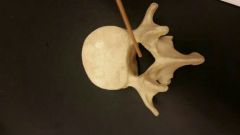
Name this part. |
Body (centrum) |
Thick cylindrical part of the vertebra responsible for bearing weight. |
|
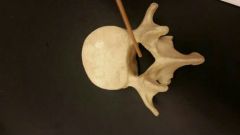
Name this hole. |
Vertebral foramen |
Hole formed by the vertebral body and arch. The spinal cord and cauda equina extend through the vertebral foramen. Together all the vertebral foramina form the vertebral canal. |
|
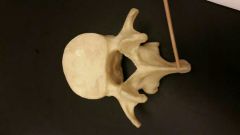
Name this part. |
Spinous process |
Midline, posterior projection of the vertebrae that is a site of ligament and muscle attachments for muscles that move the vertebral column and also some muscles that move the head, scapulae and arms. |
|
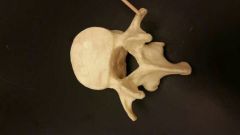
Name this part. |
Transverse process |
Lateral projections of the vertebrae that are sites of ligament and muscle attachments for muscles that move the vertebral column. |
|
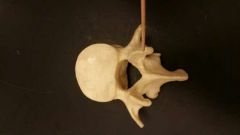
Name this part. |
Superior articular process |
The process on the superior surface of a vertebra that allows it to articulate with adjacent vertebrae. Pads of fibrocartilage called intervertebral discs are located between adjacent vertebrae; therefore the articular processes are the only sites at which the vertebrae directly articulate with each other. |
|
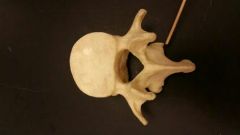
Name this part. |
Inferior articular process |
The process on the inferior surface of a vertebra that allows it to articulate with adjacent vertebrae. Pads of fibrocartilage called intervertebral discs are located between adjacent vertebrae; therefore the articular processes are the only sites at which the vertebrae directly articulate with each other. |
|
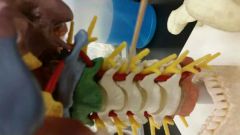
Name this hole. |
Intervertebral foramen |
Along the length of the vertabral column are lateral openings through which spinal nerves pass. |
|
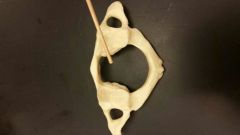
Name this type of Vertebrae |
Cervical vertebra |
(C1-C7) the smallest, lightest vertebra found in the neck. |
|
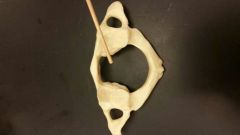
Name this bone. |
Atlas |
The atlas is the first cervical vertebra (C1). It articulates with the occipital condyles to form a synovial joint that allows for lateral skull movement (side-to-side tilt) and anterior/posterior movement (nodding head "yes") |
|
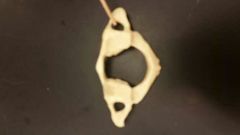
Name this bone |
Axis |
The second vertebra is the axis (C2). It has a bony projection called the dens around which the atlas rotates allowing a "no" movement of the skull. |
|
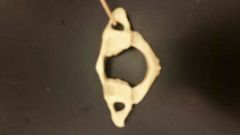
Name this hole. |
Transverse foramen |
All cervical vertebrae contain an opening in both transverse processes though which the vertebral arteries supplying blood to the brain pass. |
|
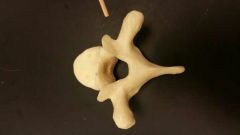
Name this Vertebra. |
Thoracic vertebrae |
(T1-T12) The vertebrae that articulates with the ribs. |
|

Name this Vertebra. |
Lumbar vertebra |
(L1-L5) large, sturdy vertebrae in the lower back. |
|

Name this bone |
Sacrum |
(S1-S5) Five fused vertebrae that form the posterior wall of the pelvis. The sacrum articulates laterally with the two hip bones (coxae) to form the bony pelvis. The articulation between the sacrum and the coxa is called the sacroiliac joint. |
|

Name these holes. |
Sacral foramina |
Along which the length of the sacrum are opening though which spinal nerves exit the sacrum (analogous to intervertebral foramina) |
|
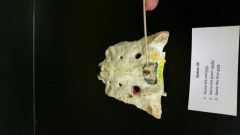
Name this hole. |
Sacral canal |
The sacral canal is a continuation of the vertebral canal. It contains the cauda equina. |
|
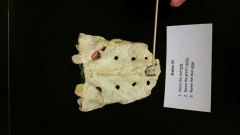
Name this hole |
Sacral hiatus |
Inferior opening of the sacral canal. Anesthetics can be injected into the sacral hiatus. |
|
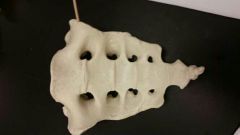
Name this part. |
Sacral ala |
Fused transverse processes of the sacral vertebra from the ala. Site of the sacroiliac joint where the sacrum attaches to the coxa. |
|
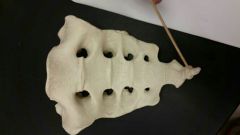
Name this part. |
Coccyx |
(Co1-Co4) then"tailbone" typically comprised of four fused coccygeal vertebrae. |
|
|
Name the exaggerated curvature of the thoracic vertebrae that causes hunchback. |
Kyphosis |
Can be caused by osteoporosis. (Hunchback) |
|
|
Name the exaggerated lumbar curvature which can be caused by pregnancy or potbelly. |
Lordosis |
Causes butt to stick out. |
|
|
Name the abnormal lateral curvature of the vertebral column. |
Scoliosis |
Spine is S shaped. |
|

Name this bone |
Sternum |
The "breastbone" is located in the anterior midline of the thorax and serves as an anchor point for the clavicles and most the ribs. The sternum connects to the ribs via cartilage called costal cartilage which allows the thoracic cage to change shape during breathing. |
|
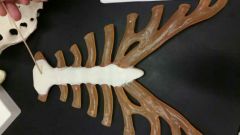
Name this part. |
Manubrium |
Superior bone of the sternum. The clavicles attach to the manubrium. |
|
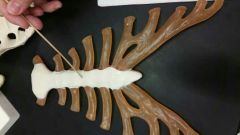
Name this part. |
Body (gladiolus) |
Main, middle bone of the sternum |
|

Name this part. |
Xiphoid process |
Inferior bone of the sternum. Site of attachment for the lines alba which is a tissue that anchors the abdominal muscles. |
|
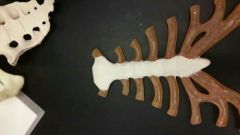
What is the name of the ribs that attach directly to the sternum by costal cartilages? |
True ribs |
(1-7) There are 7 pairs of true ribs (vertebrosternal ribs). These are the superior 7 pairs of ribs which attach directly to the sternum by costal cartilages. |
|
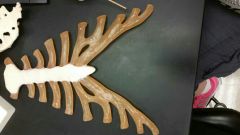
What is the name of the ribs that do not attach directly to the sternum? |
False ribs |
(8-12) These are the inferior 5 pairs of ribs. They are called false ribs because they do not have a direct attachment to the sternum. Ribs 11and 12 have no anterior attachment and are called floating false ribs. |
|
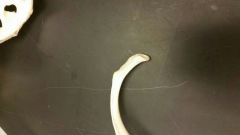
Name this part of the rib. |
Head of rib |
The rib head has an articular facet by which it attaches to the body of a thoracic vertebra (at a site called the costal facet). This joint allows the rib head to move during breathing. |
|
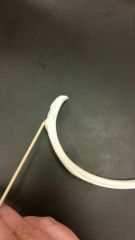
Name this part |
Tubercle of rib |
|
|

Name this bone |
Hyoid bone |
This bone is NOT part of the skull and lies just inferior to the mandible in the anterior neck. The hyoid bone is the only bone that is not directly attached to another bone. It functions to anchor throat, larynx and tongue muscles. |

